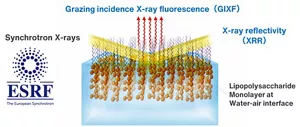Antimicrobial Mechanism at Bio-interface
Analytical Science
Understanding the nature of antibacterial actions is important for developing innovative hygiene technologies. Surfactants are a type of antimicrobial agent, though there are still many unclear points regarding how they act against microorganisms to cause effects at atomic and molecular scales.
In order to clarify the action of benzalkonium chloride (BAC), known to be effective against a broad range of bacteria, Kao undertook joint research with Heidelberg University in Germany. The action of BAC on a model membrane (lipopolysaccharide membrane) of the outermost layer of a Gram-negative bacterium at the angstrom (Å) (scale) was analyzed at the European Synchrotron Radiation Facility (ESRF), where X-ray reflectivity (XRR) and grazing incidence X-ray fluorescence (GIXF) are simultaneously measured. It was revealed that the surfactant and aromatic alcohol act on calcium ions, which contributes to stabilization of the lipopolysaccharide membrane*1 . This effect can lead to structural disruption of the bacterial surface.
Since few studies have examined antimicrobial mechanisms at the atomic and molecular scales, this is a pioneering discovery in the field of antimicrobial research. Kao researchers are striving to develop human- and eco-friendly technology, such as surfactants that produce antimicrobial effects at a lower dose, based on results obtained in cutting-edge fundamental investigations.
-
* 1 Thoma, J., Abuillan, W., Furikado, I., Habe, T., Yamamoto, A., Gierlich S., Kaufmann S., Brandenburg K., Gutsmann, T., Konovalov O., Inoue S., & Tanaka, M. (2020). Specific localisation of ions in bacterial membranes unravels physical mechanism of effective bacteria killing by sanitizer. Scientific Reports, 10, 12302.

- Home
- Innovation
- Research & Development
- Fundamental Research
- Analytical Science
- Antimicrobial Mechanism at Bio-interface
- Home
- Innovation
- Research & Development
- Fundamental Research
- Analytical Science
- Antimicrobial Mechanism at Bio-interface
